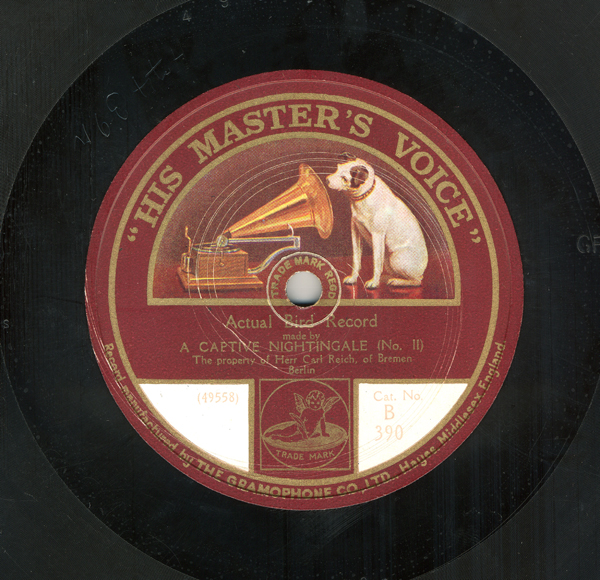The Birth of Wildlife Sound Recording
research by Cheryl Tipp
PART I
Ludwig Koch is described as the father of wildlife sound recording and is arguably the greatest pioneer in this field. He made the first ever recording of a bird in 1889, at the tender age of eight, when his father brought home an Edison Phonograph and a box of cylinders. The subject of Koch’s experiment was his pet Indian Shama, a species whose rich, melodious song made it a popular cage bird. Koch would go on to play a significant role in the development of wildlife sound recording, but the credit for producing the first ever commercial wildlife recording would go to fellow German, Carl Reich.
In 1910 the German branch of the Gramophone Company released ‘Actual Bird Record made by a Captive Nightingale’. The list of new records published by the Gramophone Co. Ltd in August 1910 described the recorded Nightingale as being a famed songster that was “taken about through Germany by its proud possessor for show purposes”. The bird in question belonged to canary breeder and bird collector, Carl Reich, who kept an aviary in Bremen, Germany and was to have a recording career that spanned almost thirty years. Eight separate recordings of the Nightingale were collected by audio engineer Max Hampe, who had travelled to Reich’s base in May 1910 to conduct this acoustic experiment. Each recording was originally released in Germany in single-sided form and copies were soon available in many European countries, including the United Kingdom, as well as the USA, Russia and even Australia (Figure 1).
The Gramophone Co. Ltd actually explained the recording process in their list of 1910, which reinforces the significance of this recording achievement. According to the promotional passage, “The cage was suspended in front of the horn, and as soon as the recording motor was set in motion, the bird began singing and did not stop when it should, as will be seen by the last note of the record, which clearly shows the bird went on singing after the instrument stopped recording.”
Reich was to dominate the commercial arm of wildlife sound recording for the next decade, with further recordings of singing Nightingales being released in 1912. The scope of this publishing programme was then widened and other birds in Reich’s collection were recorded. Successful takes were published by the Gramophone Company and Zonophone, with titles such as ‘Actual Bird Record made by a Captive Thrush’ (1913) and ‘Duet: Mock Nightingale, Garden Warbler’ (1926) being released in several countries.
The birds of Reich’s recordings were all chosen based on their reputation as versatile and talented songsters. Species such as the Nightingale, Blackbird and Domestic Canary are renowned for their sustained singing bouts and the variation, tonal quality and frequency of these songs would clearly make these popular recording subjects for both the engineers charged with recording the songs and the public listener.
For the first time ever, people could listen to a recording of an actual bird, albeit a captive one, from the comfort of their own home. This moment signified the birth of a completely new variety of sound recording for the commercial market and presented a fresh way of appreciating wildlife. No longer did the natural history hobbyist have to make do with a collection of monographs, illustrations or inanimate specimens. Sound recordings of wildlife had now come onto the scene and there was to be no looking back.
…to be continued
-Cheryl Tipp


